You can’t say you’ve been to Italy unless you visited Naples (Napoli)! The city differs so much from other Italian cities that you would even have the feeling to be in a different country! It’s quite stunning! And well, beyond fathering the original Pizza Margherita, Naples also stands alongside Pompeii, Capri, Sorrento, known as the city of Limoncello, and of course the Amalfi coast. In a nutshell: Go for it!

We landed in Naples and took a bus straight from the airport to Sorrento (1). We went then for the day to Herculaneum (2) and Pompei (3) by train. The next morning, we took the boat to Capri (4) where we spent the night. The day after, we headed towards Positano (5) and the Amalfi coast. After hiking over Positano in the Path of The Gods (6), we reached Amalfi (7). The next morning, we took the SITA bus to Ravello (8), and took a bus back to Massa Lubrense (9), in the Sorrento peninsula, to enjoy the Agriturismo experience. We concluded our one week trip by Naples (10), easily accessible by train and bus from Sorrento. Short schedule but as you will figure it out by yourself, so many things to see!
PS: As time can change significantly fast in the area, always have a rain poncho somewhere with you 🙂 Enjoy!
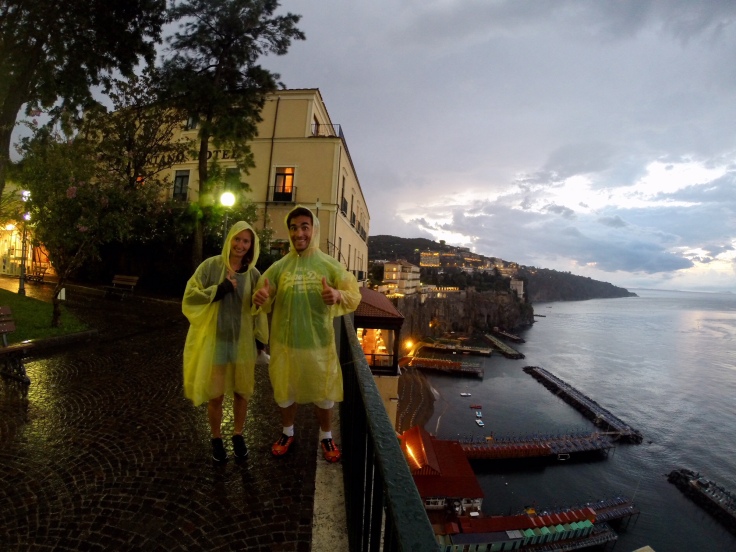
Sorrento
The city of Sorrento
Sorrento is a colorful city cramped between mountains on one side, and sea on the other. The city center is a dedication to the various local products, citrus fruits and olive oil. From there, the view on the gulf of Naples and Capri is breathtaking, and the Vesuvius omnipresent.

This part of the Mediterranean Sea is not endless beaches with white sand. As the Aeolian volcanic islands in North of Sicily, the sand in the Amalfi coast is dark, due to the Vesuvius eruption of 79, and the cliffs surrounding the seafront are preventing the access to the sea. The fishermen harbor gives a lot of charm to the city, with the small boats all along the cliffs.

Sorrento is the city of limoncello, and lemons are everywhere. Painted lemons decorate the pavement on the street, lemon trees are surrounding the city, lemons fill stalls of all fruit sellers, and the air of the city center is full of the smell of lemon soap, sold everywhere.
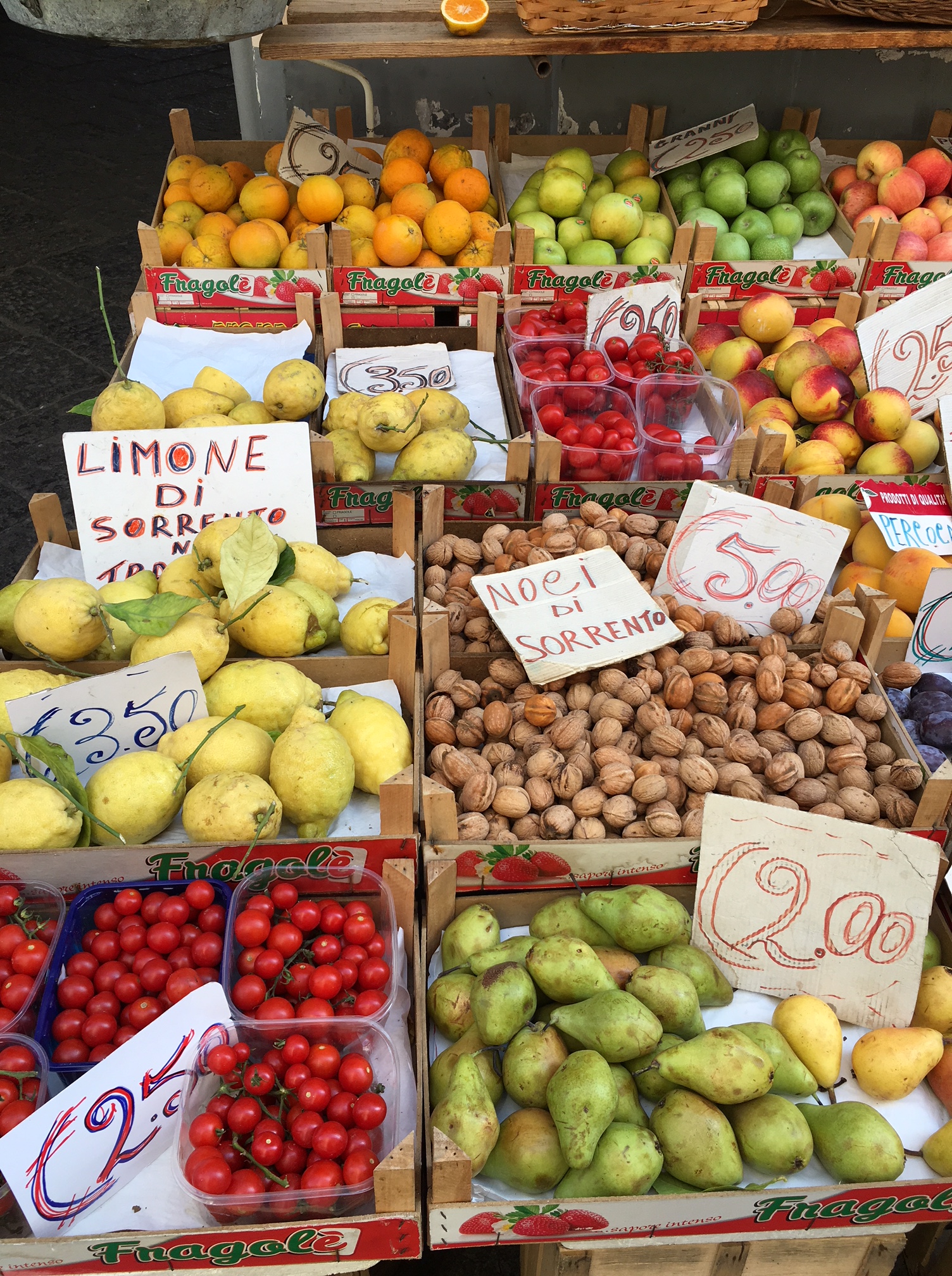
One Place To Eat: Porta a Marina – Restaurant on the fishing port, at the end of the wharf.
Fishermen come directly after the fishing to drop their catches to this restaurant. They will serve you the fresh fish with a glass of wine from the area. Simply amazing!
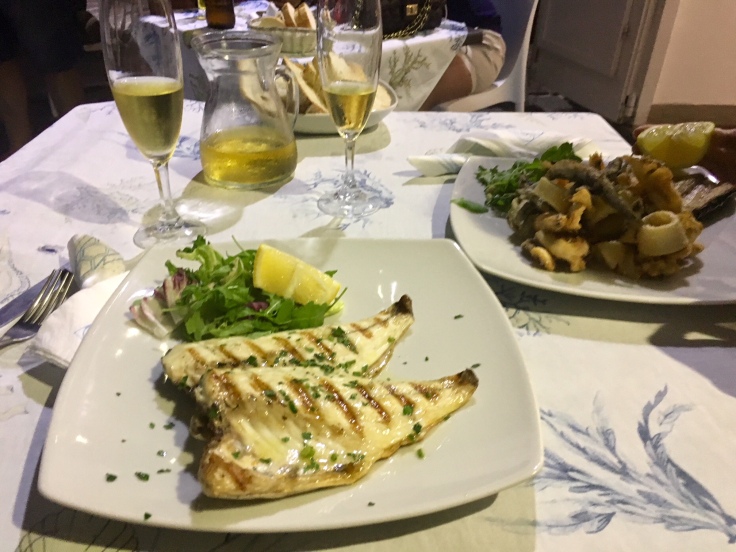
Sorrento is divided in two parts: an uptown, where you’ll find most of the shops, restaurants and view points on the Gulf of Naples. And a lower town, made up of a few beaches, the harbor from where all boats for Naples, Salerno, Capri and the gulf of Sorrento leave, but also the fishermen harbor, called Marina Grande. Stairs and one elevator not far from the beach connect both parts of the city.
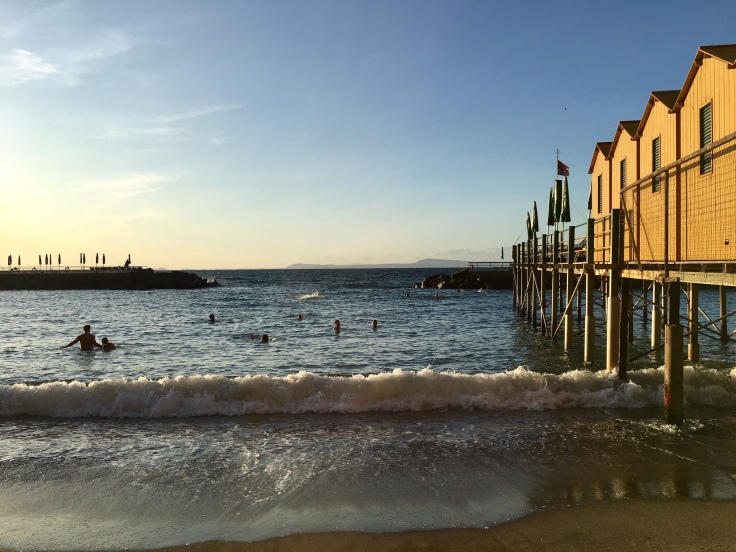
You should take the boat on departure or arrival to Sorrento to realize how high the mountains around are, and how steep the area is. Mountains overhanging Sorrento culminate to 1131 meters.
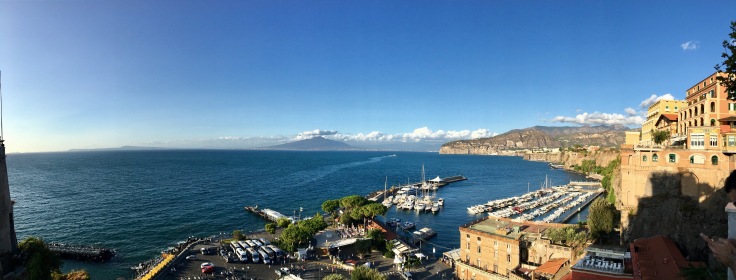
Sorrento Peninsula
The Sorrento peninsula goes far beyond Sorrento, up to the Punta Della Campanella, and several beaches, much quieter than the ones in Sorrento –as below, La Marina di Puolo, lined with fishermen’s houses.
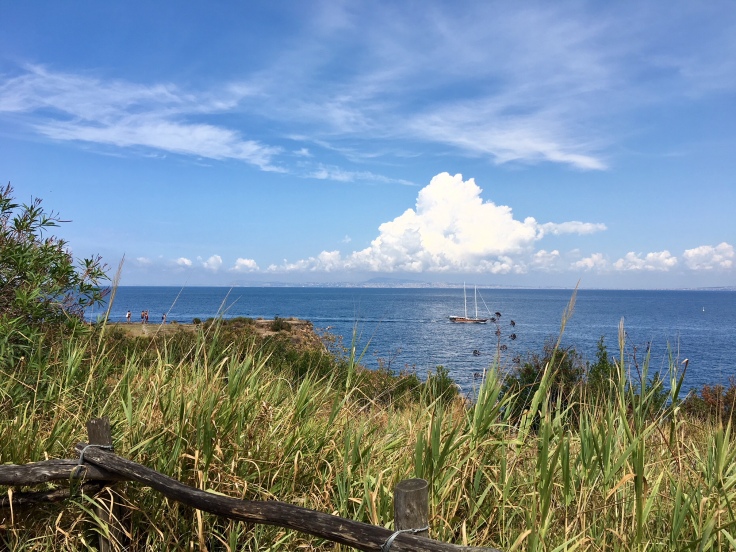
Few people take the time to go from Sorrento to Massa Lubrense because buses are not that frequent and a bit far from the city centre. However, il bagno della Regina Giovanna, not far from La Punta del Capo, is amazing!

Il bagno della Regina Giovanna is a small rocky cove where the sea enters by an arch, which makes it a place for bathing entirely protected from the waves and currents, with a crystal clear water. The site shows some ruins of what was a former roman villa, the villa Limona belonging to Pollius Felix, a wealthy roman citizen, at the beginning of the first century.

We stayed one night out of Sorrento, in Massa Lubrense. If you haven’t heard about it yet, it’s time to check about the concept of Agriturismo. The program, born in Tuscany, and sponsored by the Italian Chamber of Commerce, encourages people to sleep in farms all across Italy. The concept is simple: you sleep in the farm, and discover its products in the same time.
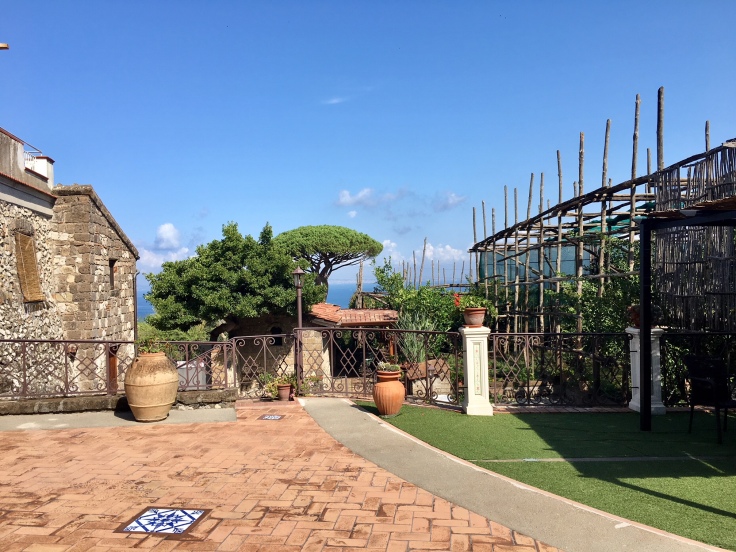
One Place To Stay: Il Gardino di Vigliano.
The farm, not far from Massa Lubrense, is kept by Valentina, Luigi and their mother, and in the family since the XIV century. The farm produces lemons and oranges mainly, and all the products derived. Being hosted there was one of the greatest moments of our trip. The family is with an unlimited kindness, inviting us to cook our own pizzas with them and using the farm products! Best pizza ever! If you don’t know how to make mozzarella, then you must have a stop there.
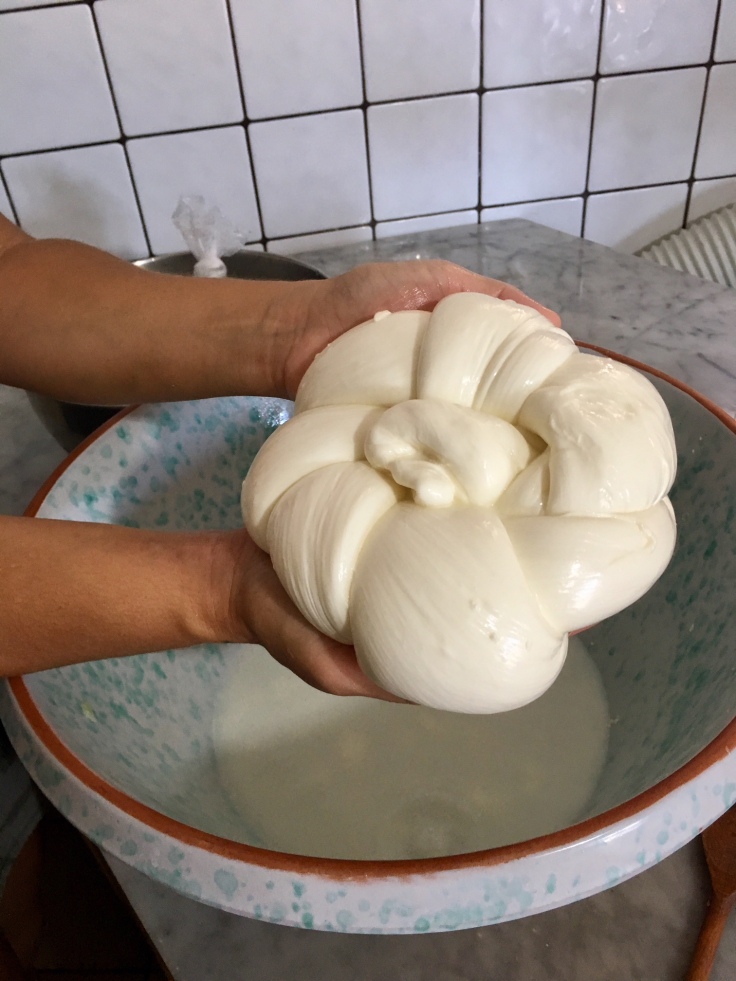
Herculaneum and Pompeii
You can’t go to Naples and on the Amalfi coast without stopping by the masterpiece that is Pompeii! As part of Europe’s history, it’s a must see! And I have to say that both Herculaneum and Pompeii are impressive! Different though. Pompeii is impressive by its size and how organized the city was. Conversely, Herculaneum shines through the fineness and variety of its mosaics, but also its modernity.
Both sites are accessible by train from Sorrento and Naples. As the two places can easily be overcrowded, if you want to skip the queue, think to buy your ticket online at least one day before your visit.
Herculaneum
In 89 bc, Herculaneum, previously under the Greek influence, fell under the Roman Empire. Wealthy city of approximately 4,000 inhabitants alongside the Mediterranean Sea, its life stopped suddenly with the Vesuvius eruption in 79. Ashes from the volcano overlaid the entire city and pushed back the waterfront by 400 meters. 1km² is uncovered while 19 others rely on what is the actual city of Ercolano.

Accessing Herculaneum is easy: from the train station Ercolano Scavi, you just have to go down the main street via IV Novembre for 5 minutes; the archaeological area is at the end.
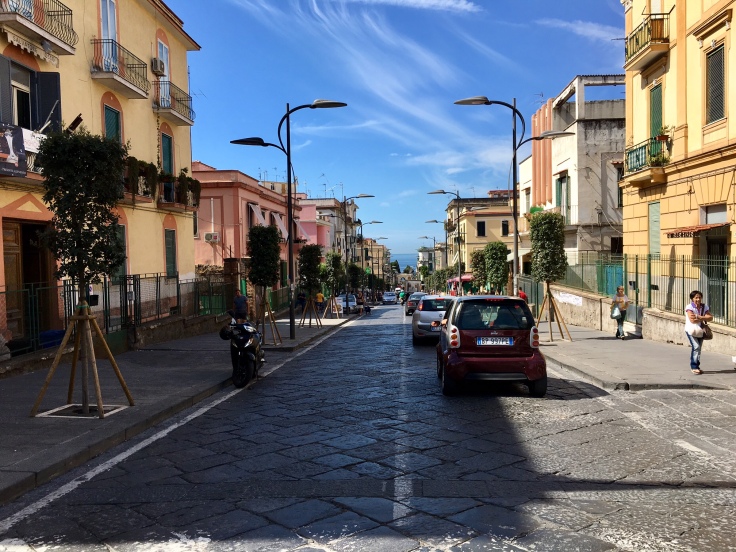
One Place To Eat: Pizzeria Luna Caprese – Pizzas and seashells pastas are amazing there. Quick service and terrace on an animated and lively pavement.
Ashes, surprisingly, kept in good shape all the mosaics and houses. Maps and documentation provided at the entrance of the site give you a clear idea of how the city worked back then.
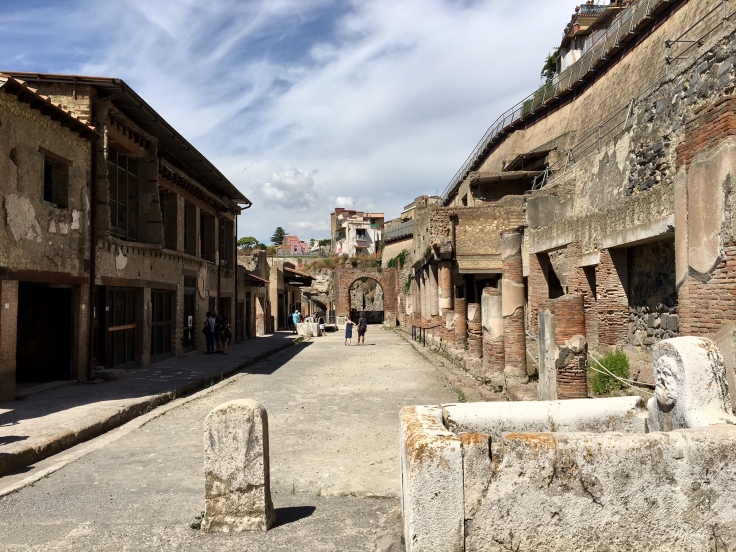
Baths and thermopoliums (bars and restaurants) occupied a prominent place within the city, so you can find one at the corner of every two main streets.
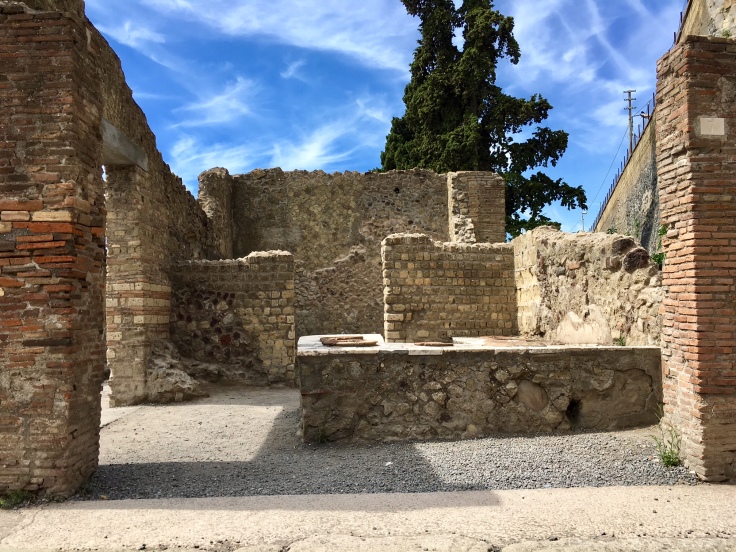
Mosaics and houses from different styles – depending on the time of construction- are stunning. Besides, Herculaneum is more pleasant to visit as less known and consequently less crowded than Pompeii so you can take your time to understand how the city ruled.

Pompeii
A first earthquake shook Pompeii in 62 and damaged many buildings which consequences can still be observed on the front of many houses. The city disappeared the same day as Herculaneum, in 79. Pompeii was accidentally discovered in 1590. However it is only in 1750, under the reign of Louis XV, that people realized how important the site was, in terms of history, architecture, way of life under the Roman Empire, etc.
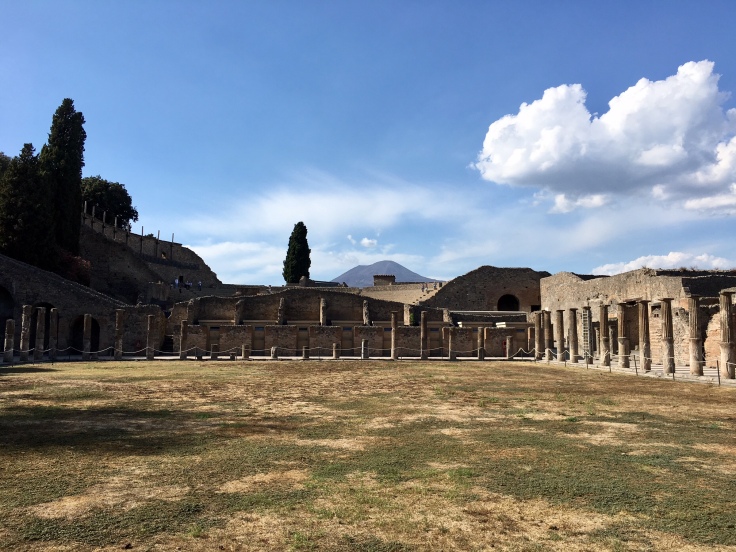
Pompeii is much bigger than Herculaneum, with more than 20,000 inhabitants, over 20 km². The site remains more impressive than Herculaneum as all of it has been uncovered. Pompeii is divided in nine different areas: from the public neighborhood where the forum stands to the trading areas where inhabitants were selling and exchanging products, everything was well organised.

The forum was the nerve center of the city. Located on the highest point of the hill, with a great view on the Vesuvius and the Sorrento Gulf, it demonstrates how big the city was at that time.
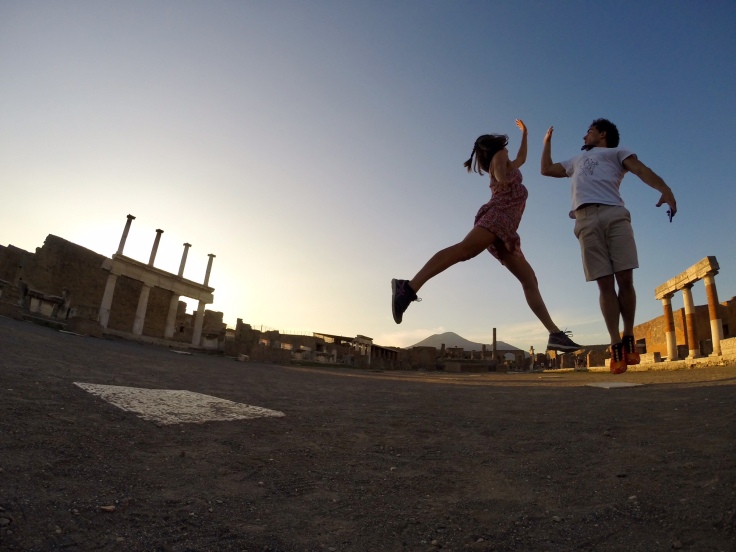
Each neighbourhood has to be visited through its tiny streets called vicoli, in order to leave the crowd and see typical Pompeii houses.
One of the most known houses of Pompeii is a house dedicated to prostitution, called Lupanare. In Latin, lupa means prostitute. Frescoes on the walls were there to give the client an idea of the different services provided in the brothel. However, while walking on Pompeii streets, other similar houses can be recognized (looking at the signs on the two pillars of the house – quite explicit).
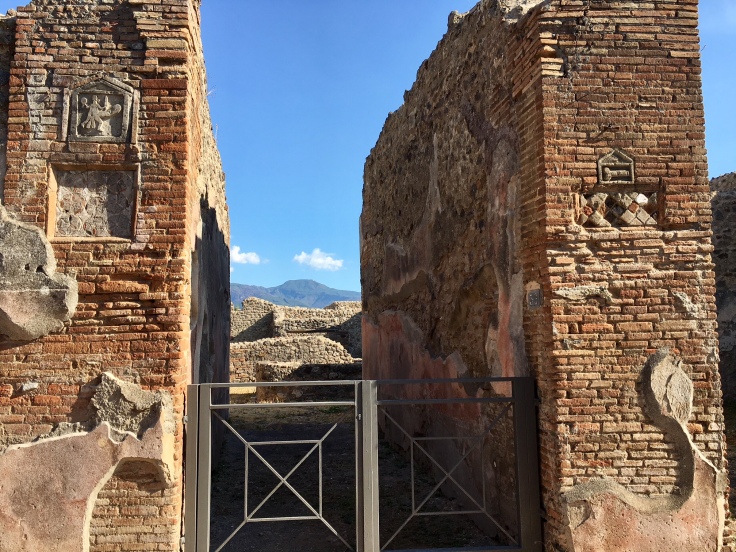
Wealthy people were living in really well decorated houses whose mosaics and architecture still are well conserved. Many of these houses are located in the area 6, the aristocratic city, and the area 1, the commercial city.
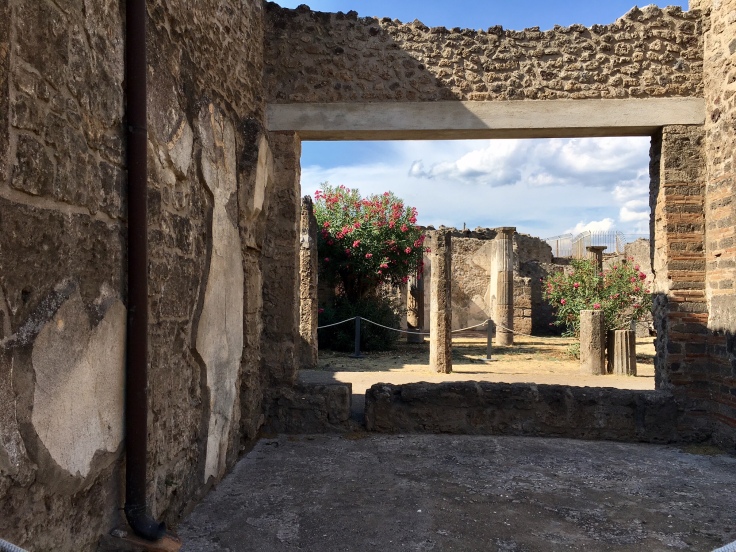
As for Herculaneum, baths and thermopoliums are frequently juxtaposed at different corners of the city, especially around the forum and living areas. As every Roman city, Pompeii had its amphitheater, at the opposite side of the forum, its theater and area for gladiators.
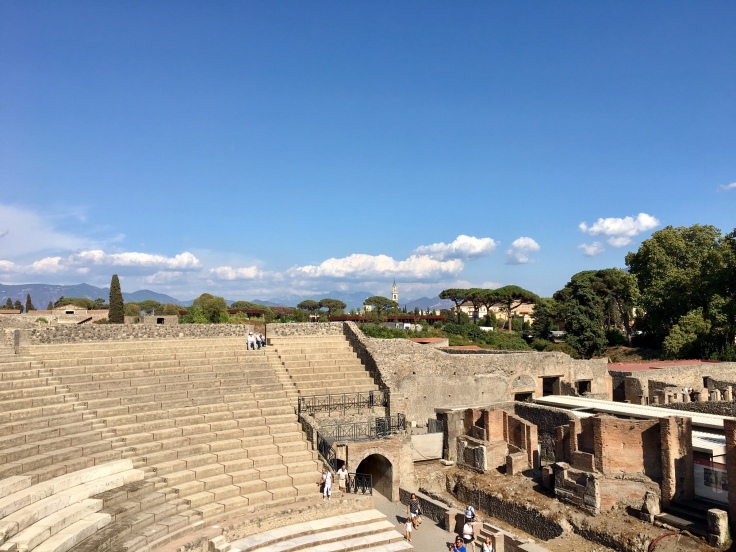
Funny fact, pedestrian crossings were already invented at the time of Pompeii! Within the entire city, sidewalks are higher than the roadway. In order to avoid pedestrians to step down from the pavement to cross the street, they built pedestrian crossings at regular intervals in all the streets, at the same high than the sidewalks. Built as such, carts were easily able to cross them as well.

In addition to the nine different areas of Pompeii, the area 10 needs a closer look though: outside the walls of Pompeii lays the Villa dei Misteri, the villa of mysteries. Built in 200bc, it is one of the most beautiful houses of the site. In one of the rooms is one of the best-preserved frescoes of that time: 29 life-size characters, most likely representing the initiation of a bride to the Dionysian mysteries – at that time, Dionysian cults were widespread in the south of Italy.
Capri
The island, 3 km wide for 6 km long, which can be seen from Naples and the entire gulf of Sorrento, is enchanting. As the entire coast in the area, do not expect endless beaches when going to Capri. The island is a rocky outcrop where every track is steep, with a climax point, the Monte Solaro, at 589 meters above the sea.
Capri abounds of sites to visit! Be ready for a walk, and wear your hiking shoes to enjoy the Capri experience fully 🙂

All boats arrive in Marina Grande, the harbor of the island. What is really nice about the place is that despite the many tourists, they manage to keep the authenticity of a fishing port, with all colorful boats and houses.
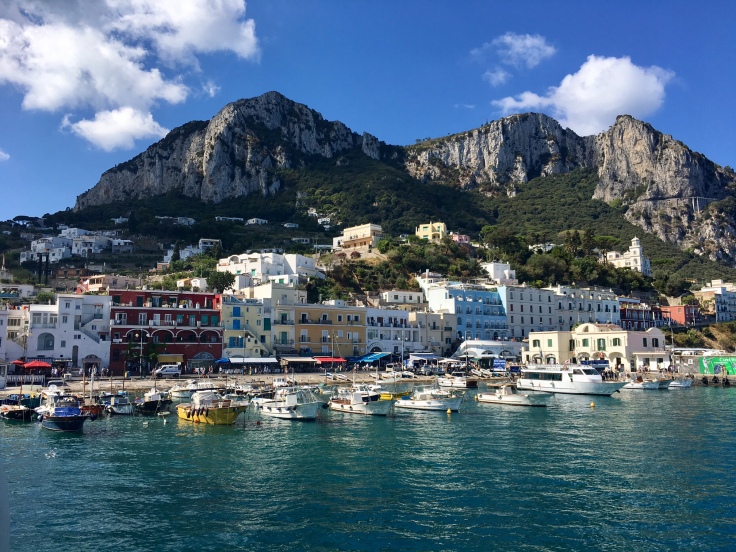
You have two options to get to Capri or Anacapri from Marina Grande: or you take the funicular (Capri) or the bus (Anacapri). But you have to keep in mind that the funicular can fit up to 30 people, and buses only 20 – small buses for narrow and steep roads. However, if you prefer to go to Capri or Anacapri by foot, stairs are the alternative option; and stairs definitely worth it! The view on the gulf of Salerno, either on the way to Capri, on Via San Francesco, or Anacapri on Scala Fenicia, is worth it!

Anacapri is the second main city of the island, lying at the foot of the Monte Solaro. Stairs from Marina grande lead you to the Capella di Sant’Antonio, and then to the villa San Michele, at the entrance of the city. Small pedestrian streets alongside the mountain run through Anacapri. The Chiesa San Michele, downtown, has its pavement representing the earthly paradise, Eve and Adam, and for sure, at its top, the defended fruit.
One Place To Eat: Aumm Aumm – Restaurant known for the best pizzas of the island. Located outside from the city center, the atmosphere here is authentic Italian, and pizzas cooked in a wood fired oven are amazing.
From Anacapri there is a chairlift taking you to the top of Monte Solaro, the highest point of the island. The alternative option is to go by foot: a gently sloping path, via Monte Solaro, leads to the top. On the road, you will pass different viewpoints on the gulf of Sorrento, Naples and the Amalfi coast!
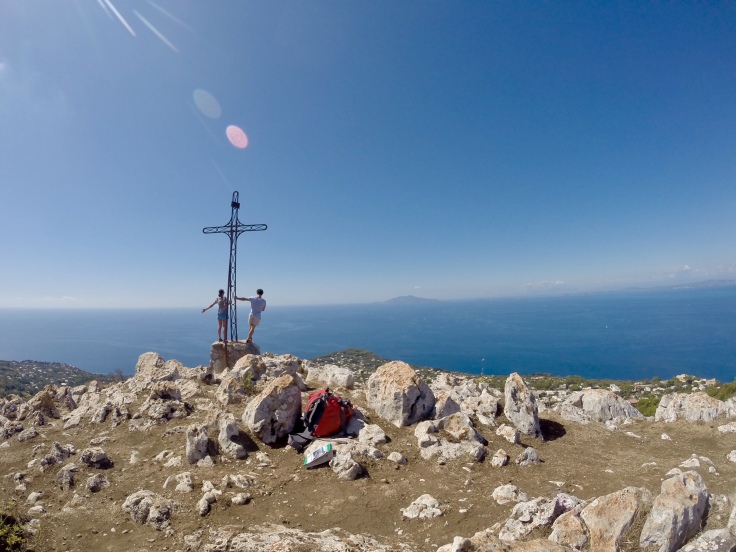
At the top of Monte Solaro, the panoramic view, surrounded by blue crystal water is breathtaking! But what’s even more breathtaking is the way down to Capri from there! A small track goes down from Monte Solaro to the monastery of Santa Maria a Cetrella, from the XIV century.

From there, a steep single track, il Passetiello, overlooking the sea from hundreds of meters, reaches Capri, with a stunning view on Capri, the Villa Jovis at the east end of the island, and I Faraglioni, the gigantic rocks which rise up out of the sea at the south east end of the island.
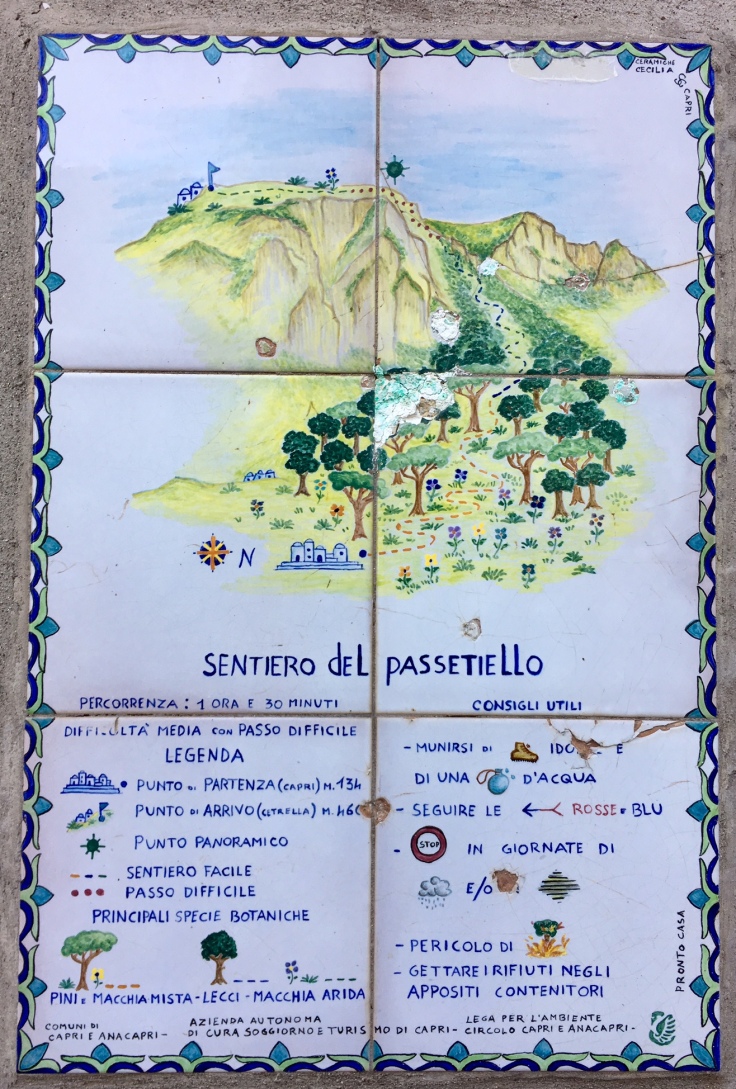
The track from Monte Solaro to Capri arrives in Marina Piccola, a small village in the prolongation of Capri alongside the seafront, with wild gardens and quiet pedestrian walks. Swimming there is impressive, being surrounded by the steep cliffs all around. The ride is much nicer from Monte Solaro until Marina Piccola than the other way around, as very craggy.
Capri is a beautiful city. You can stop wherever you’d like, the view point will still be amazing. Pedestrian streets, delicatessen, luxury stores and typical houses from there cohabit altogether.
One Place To Have Breakfast: Buonocore Gelateria – great home made pastries, cakes and deserts
However, easily crowded, the city will charm you the most between 6pm and 10am, when all daily tourists leave the island. Taking the Aperitivo on the main square in town, piazza Umberto I, overhung by the Santo Stefano baroque dome, is a must do! At that time, the light of the sunset going down on the gulf of Sorrento illuminates the square, it gets magical.

From piazza Umberto I, also starts the road to go to The Villa Jovis. Roman emperors Augustus and Tiberius were the first known persons to live on the island: Tiberius even spent the last 10 years of his life running Rome from the Villa Jovis! The path to get there, via Tiberio and via A.Maiuri, crosses the city of Capri. Even though the remains are quite damaged in a few places, the tour gives you an idea of how magnificent the villa was back then, on the top of the Monte Tiberio. Be careful with opening hours though, as varying depending on the season.

Just before the entrance of Villa Jovis, a small single track goes to the left. Take it! No signs indicate it, but the track goes back to Capri along the cliffs and the sea, stopping by Villa Lysis in the meantime.

The Amalfi Coast
Positano
We arrived in Positano by boat, from Capri. The view on the Amalfi coast from the boat shows you that this side of the seafront is even steeper than the Gulf of Sorrento, and it goes easily from the sea level to more than 700 meters. Positano appears suddenly on your sight, which makes it even more special.
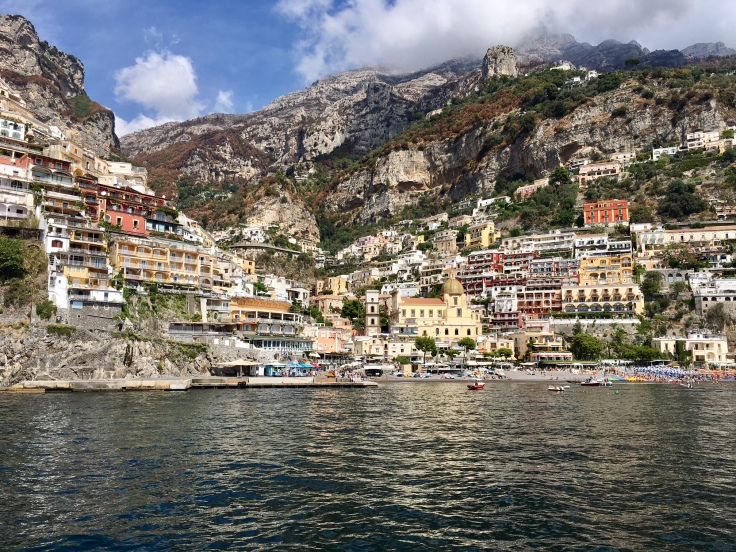
Positano is the most touristic city of Italy. The city is located down two valleys, between steep mountains falling into the sea. Seafront relief makes it difficult for boats to arrive: there is no harbor in Positano, the boat just drops you on the landing stage and leaves afterwards. However, due to the boat traffic, the water is not crystal clear as it was in Capri! But the view while swimming is one of the kinds.
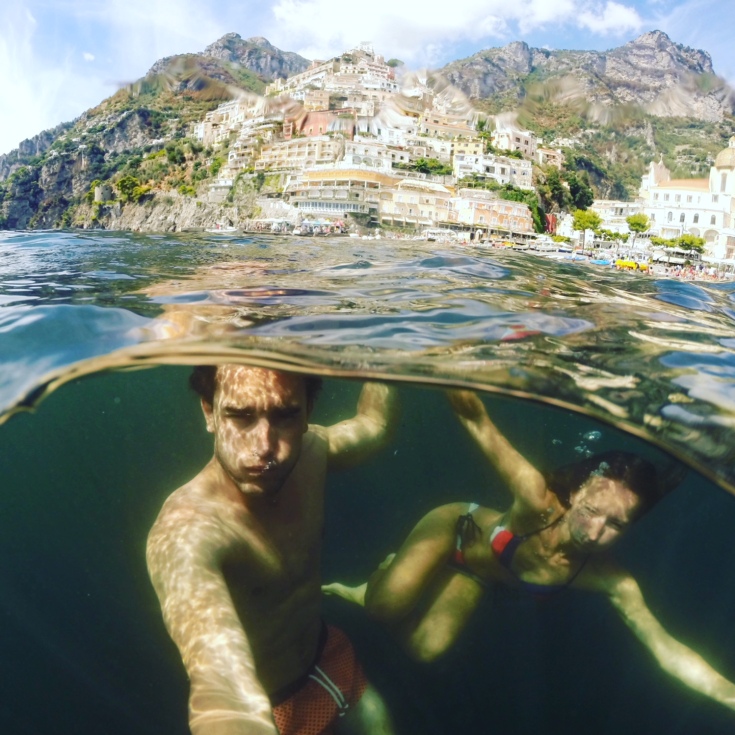
Due to its steep lands, cars are mostly missing in Positano. Two main roads cross the city, which makes it entirely for pedestrians. All viewpoints are more astonishing than the other, with all these colorful houses and view on the Mediterranean Sea.

One Place To Eat: The Grottino Azzuro – You have to take seafood pastas at this restaurant! They are insane!
A bus from Positano takes you, every hour, from the center of Positano to Nocelle (bus stops available at the tourist office, just after the marina). From Nocelle starts the Path of the Gods. And this is amazing!
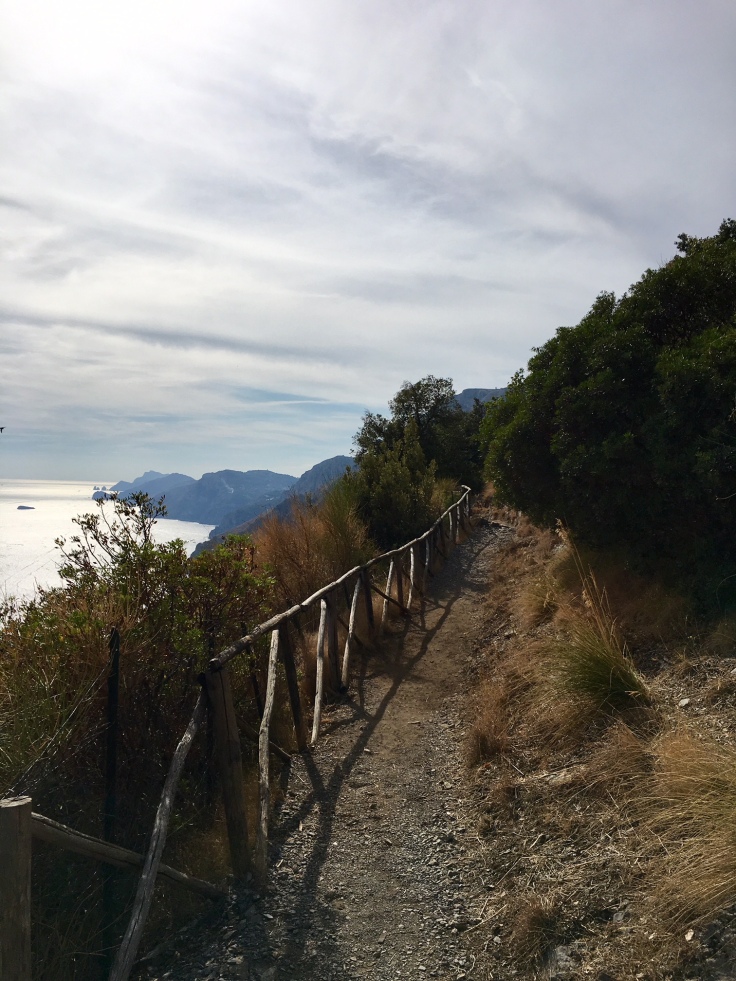
The Path of The Gods is a ride alongside the cliffs, 400 meters high, joining Nocelle to Bomerano in approximately three or four hours. But you can –slightly- change this. We joined Praiano instead of Bomerano for two reasons:
- Firstly, there is, on the way down to Praiano, a former monastery from the XIV century, called Monastero San Domenico. It is surrounded by tiered gardens that you can visit. The path going down to Praiano is a (former) way of the cross to the Monastery. The XVI century cross used at the time still belongs to the church. The view on Positano from the balcony, the Amalfi coast, at sunset, leaves you speechless.
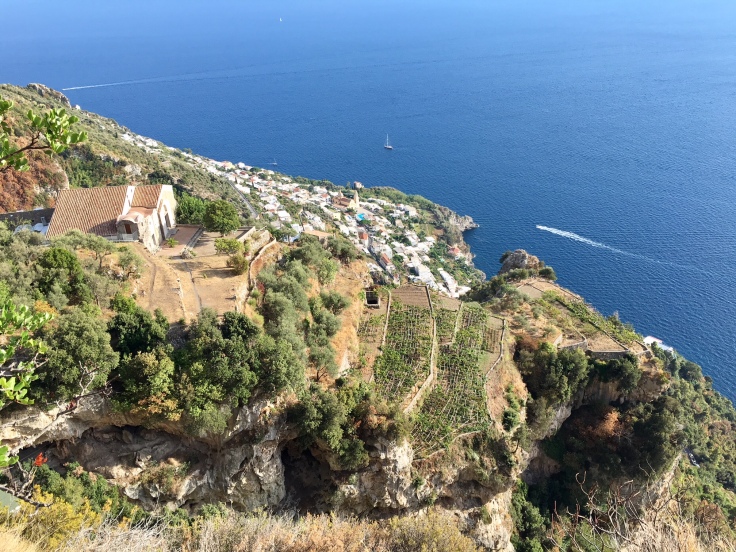
- Secondly, after walking under a sun of 30 degrees, skipping a swim in the sea was not an option! Indeed, the original ride goes from Nocelle until Bomerano. However, Bomerano is a village in the mountains, no access to the sea, unlike Praiano. However, regular buses take you from there until the city and its various beaches.
PS: Hiking shoes mandatory!
Praiano
Praiano is a pleasant small fisherman village at the feet of the Sant’Angello Mountain. The access to the beaches, as Vettica Maggiore or Furore, goes through narrow streets and steps alongside the cliffs.
One Place To Have Aperitivo: Cafe Mirante. Between all these narrow strets,the beach bar, run by a really nice guy and his mum, has a stunning view on the Amalfi coast and Positano, especially on sunset. Plus, Aperol Spritz is excellent 🙂
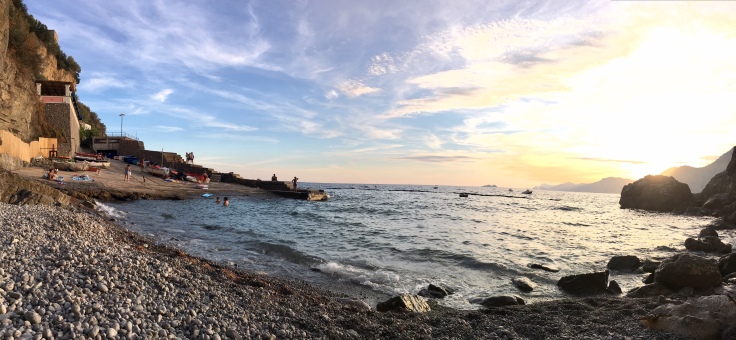
Amalfi
We reached Amalfi from Praiano by bus. Between the mountains and the sea, the city has a glorious past. In the XI century, the city had up to 60 000 inhabitants and was a rival of Genoa and Venice in terms of maritime power. In the main square, piazza Duomo, the cathedral, il duomo di Sant’ Andrea, shelters many relics of various saints. The crypt and the cloister, from the IX century and partially reconstructed in the XI century, are highly decorated.

The city differs significantly from Positano and Praiano due to the originality of its construction, stairs and intertwined lanes. A rainy atmosphere gives you the impression to evolve inside a painting, as all colors mix themselves altogether very well.
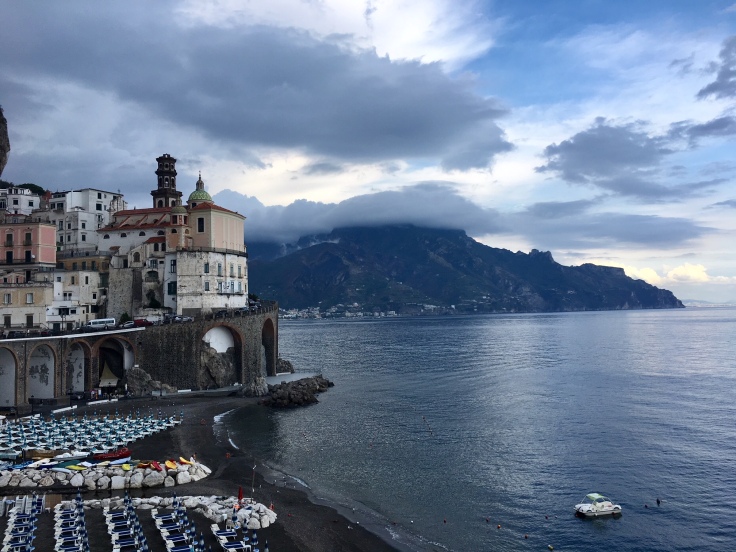
Ravello
Ravello has a common history with Amalfi, as integrated to the Amalfi Duchy from the XI century. The city, built on a rocky spur, overhangs Amalfi. Like Amalfi, Ravello had a glorious time in the XIII century, while exchanges between Europe, Sicily and Orient were at their peak.
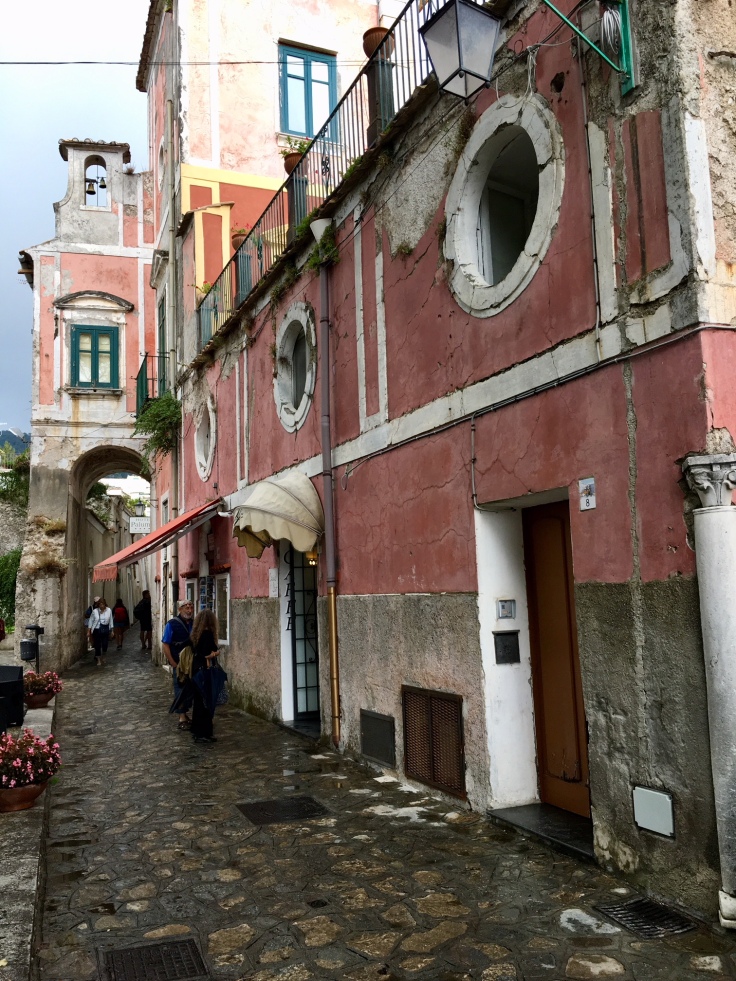
From the main square, the via Francesco leads to the villa Cimbrone! Built by a Lord in the XIX century on the basements of a former roman villa, he integrated in the villas former antic decorations, which makes the site unique. So is the view from the terrace.
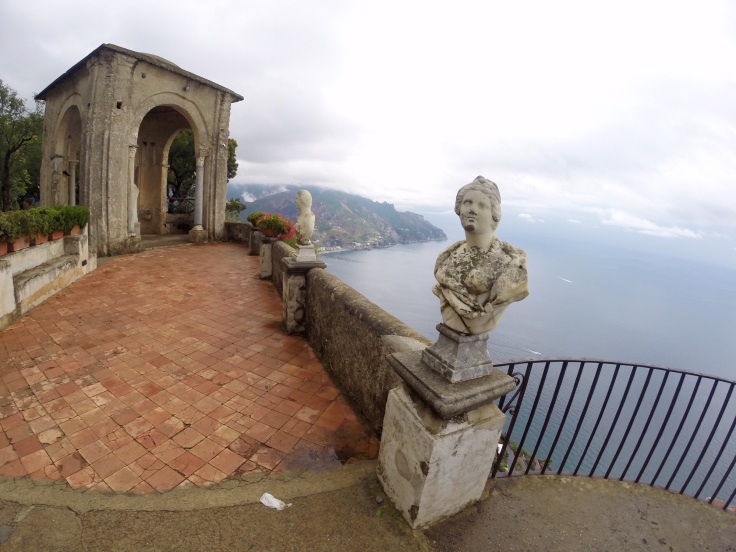
Walking in the streets of Ravello, pay attention to all the Arabic details Moors left while doing trade with the city in the XIII century. The view from the main square and the duomo, built in the XI century, completely differs from what you’ve seen so far on the Amalfi coast.

One Place To Eat: Nino’s Pizza – As a touristic place, many restaurants can be found downtown. However, if you walk 5 minutes outside the city center, you will find Nino’s Pizza. At first glance this place will not catch your attention but their pizzas are amazing!
On your way back to the city center, stop by the gelateria Baffone (Big Moustache in Italian) , an authentic home-made ice-cream for the dessert 🙂
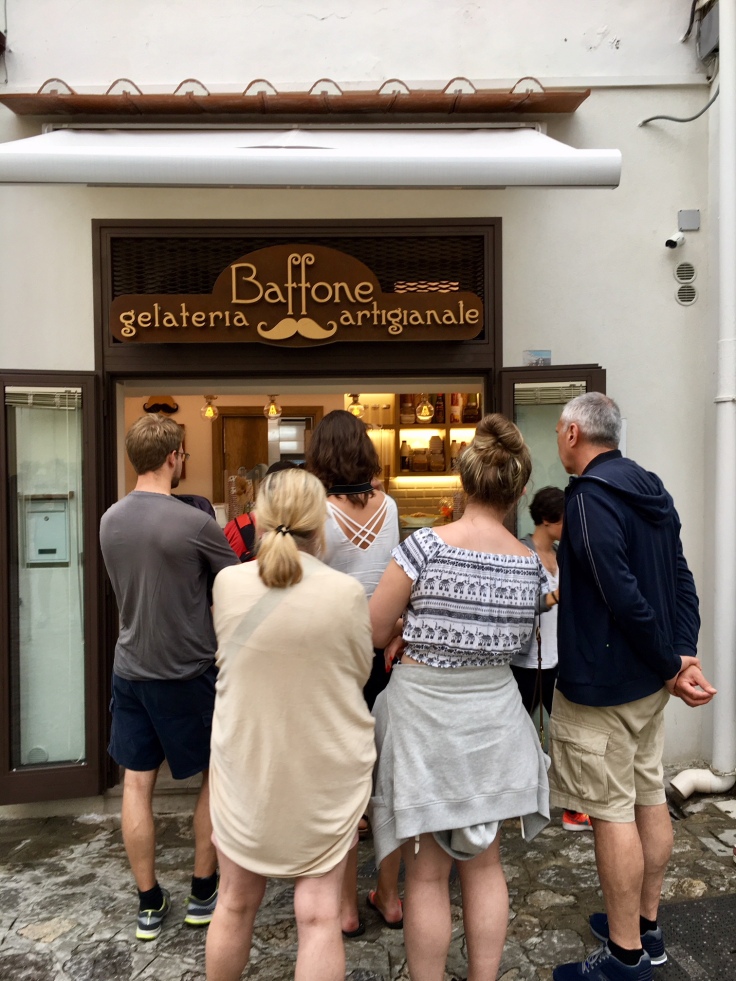
At the end of the day, queues for SITA buses can be very long. We took the stairs for the way back to Amalfi. The path goes sinuously through the cliffs between two fields of lemon and fig trees, for a 45 minutes’ walk, and a great view on Maiori, Amalfi, and the sea.
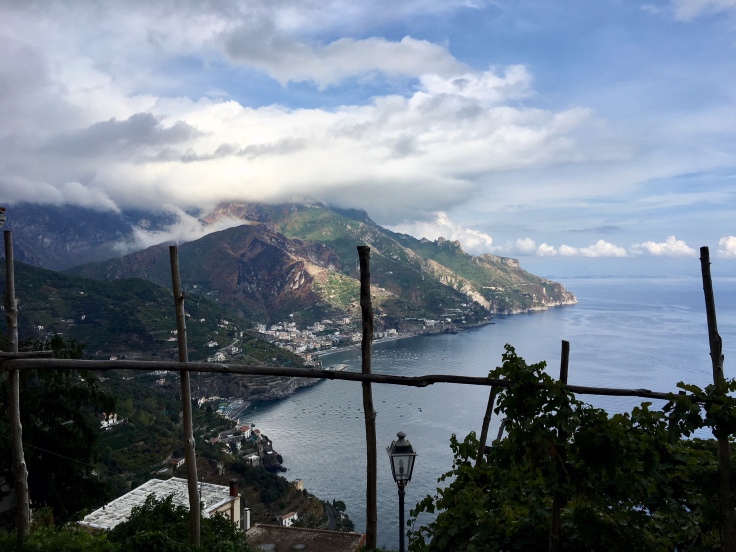
Naples
Naples is a city apart from the rest of Italy. The atmosphere in the streets is unique. Lively, crowded, horn sounds everywhere, scooters slaloming between pedestrian in narrow streets, the smell of pizza … The list would be long to describe Naples. But to give you an idea of how it works in Naples: New York has 8.5 million inhabitants, for 1200 km2. Naples 1 million, for 117 km2. However, the same numbers of cars run the city every day than NYC. As a matter of fact, we decided to reach Naples by public transportation instead of renting a car. And as a summary of the Neapolitan driving:

Naples is the third biggest city of Italy, after Rome and Milan. It is one of the oldest as well, whose destiny is intimately linked to Pompeii and Herculaneum. The city was built on a large panel of civilizations and cultures; Spanish and French influences are scattered all across Naples. Naples abounds with architectural treasuries, and two days is the strict minimum amount of time you will need to explore part of them. It is a good idea to have a travel guidebook with you while discovering Naples: a significant part of amazing palaces are hidden behind a first wall so you wouldn’t suspect that they were there!
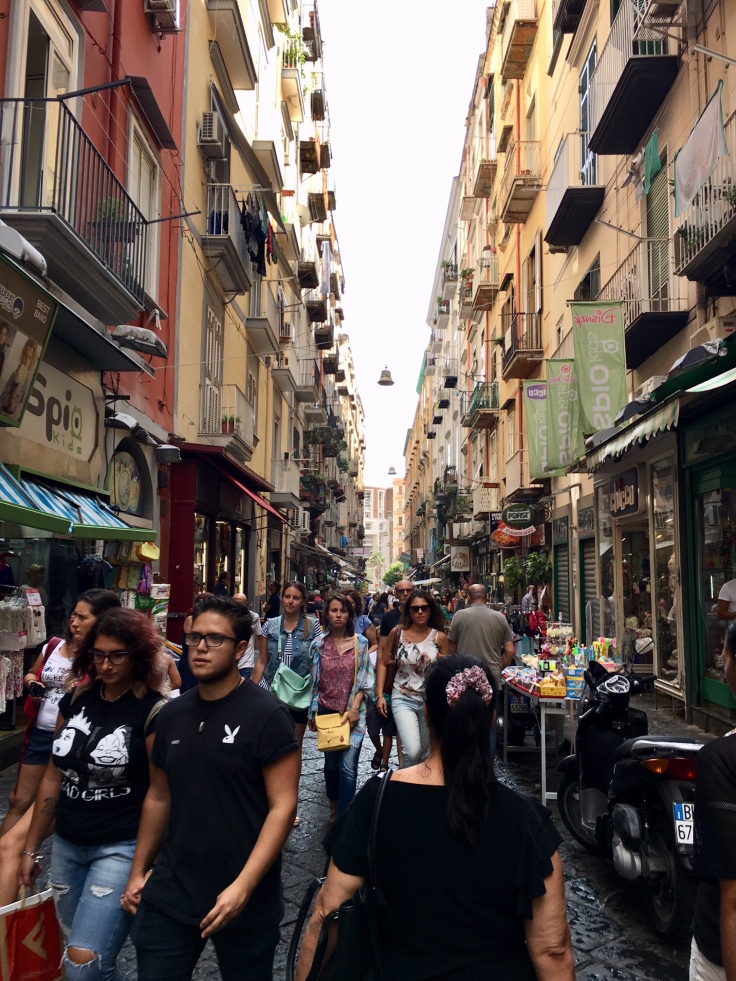
One Place to Eat Arancini: Antica Pizzeria e Friggitoria Di Mateo on via Tribunali. Great arancini served quickly in case you want to eat fast – and eat something else than pizza
The historical center starts via Duomo. From there, a large part of Naples history is located between Via dei Tribunali and via San Bagio Dei Librai. These two streets concentrate an incredible number of churches – and pizzerias.
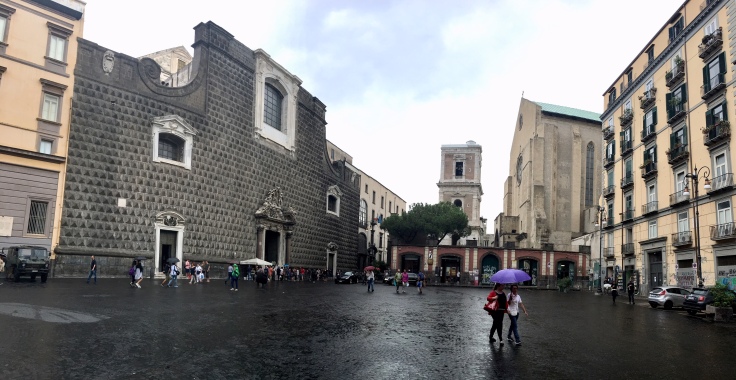
You really should stop to every church in Naples. Even though they do not appear amazing from the outside, I can assure you that the inside abounds of various treasuries that worth to be seen! Among all these churches, two are flabbergasted and must be visited: Chiostro e Monasterio de Santa Chiara, for its courtyard and history, and Chiesa del Gesù Nuovo, located just in front, in a complete different style with a magnificent inside.

Part of the history of Naples, Napoli underground, is a must-see, and a really cool one hour and a half visit. Before the Roman Empire, the Greeks built Naples, christened Parthenope at the time, as perfectly located for trading. Water was missing and aqueducts were built from the mountains around to provide the city. Once in Naples, the water was stored in giant reservoirs underground and redistributed, through public networks but also private, for wealthy citizen. In 1852, aqueducts were shut down, and, until 1942, Napoli undergrounds became a giant dump. The city being under the Allied bombs, the city mayor decided to use the underground networks to protect the citizens. Garbage couldn’t be removed, as too time consuming. So they pressed it.
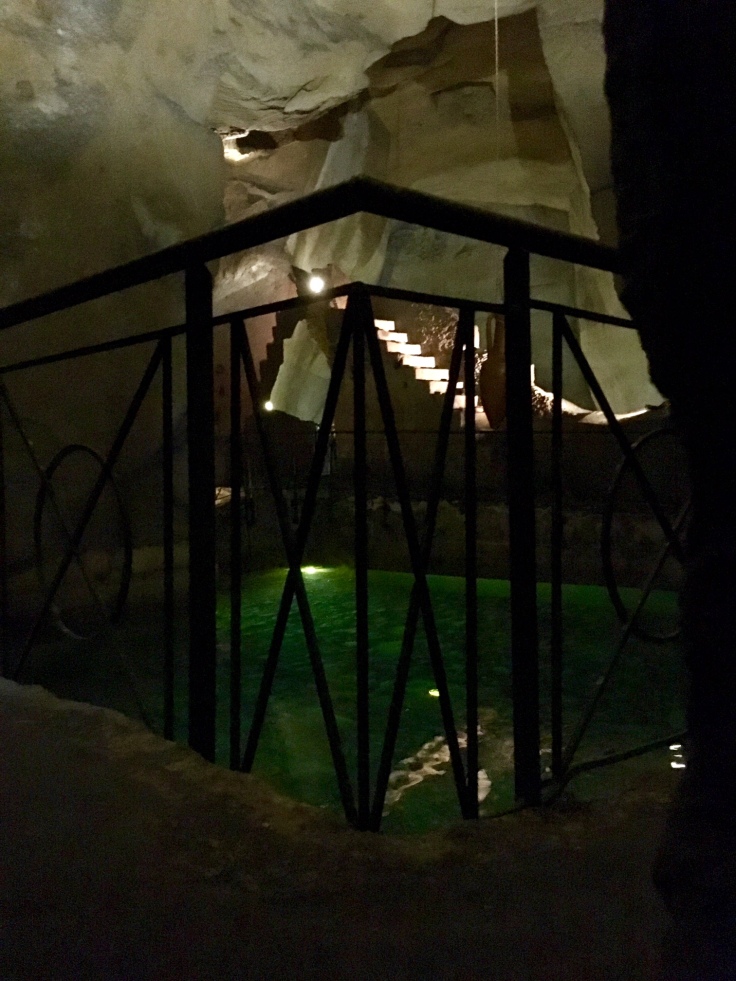
Not far from via dei Tribunali and via San Bagio is the piazza Bellini, circled with bars, students and good Aperol Spritz. Piazza Dante, where is located the Foro Carolino, opens on via Toledo, one of the biggest streets in Napoli center.
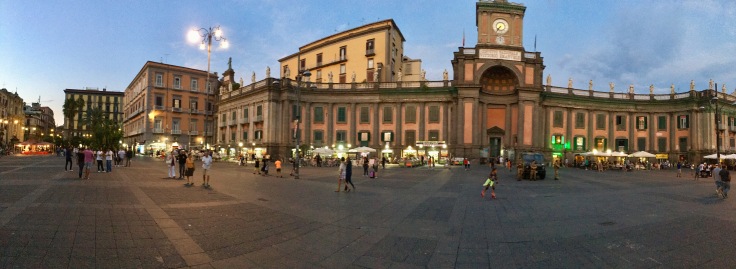
Going down via Toledo, on the right, is the Spanish area, the Quartieri Spagnoli. Hillside differs from the historical center in terms of architecture: all bars and shops!
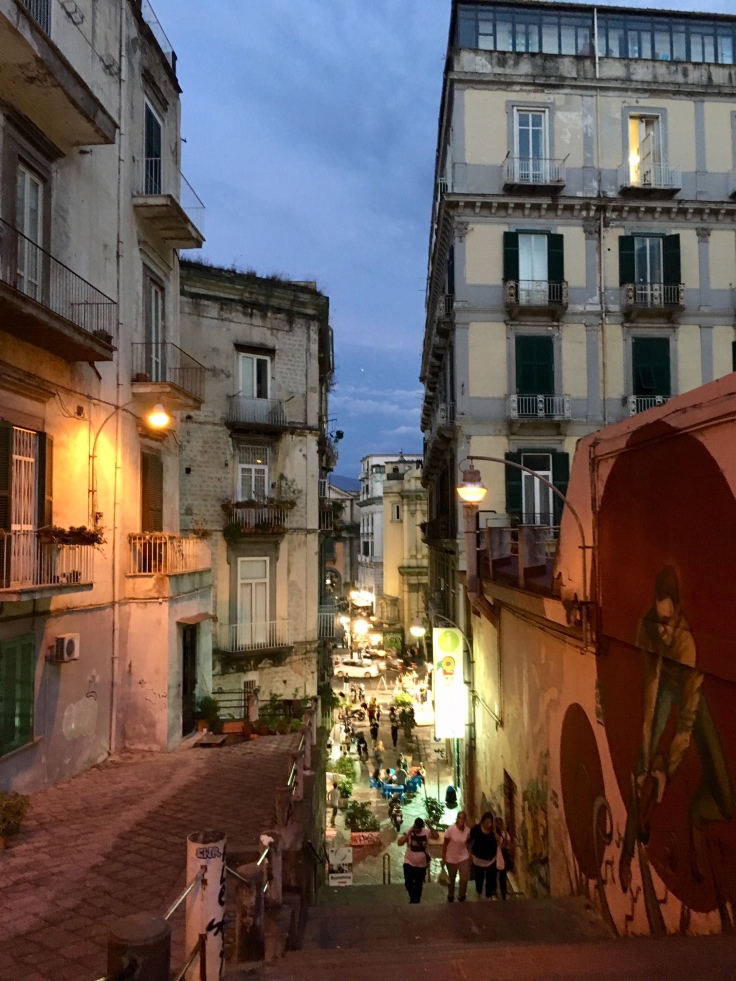
Walking upstairs, the Pedamentina a San Martino leads you to the Castel San’ Elmo and belvedere San Martino, and gives you the best of the two bays of Naples. From the summit of Vomero a great view on the Vesuvio stands in front of you. On one side is Chiaia, the area alongside the sea and its Chiaia Riviera, il Castello dell’Ovo, and the sea.
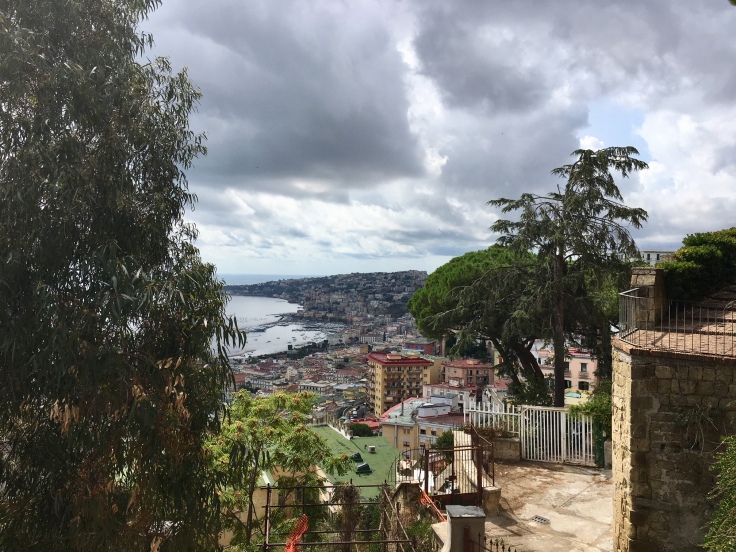
On the other side are the Spanish neighborhood and the historical center.
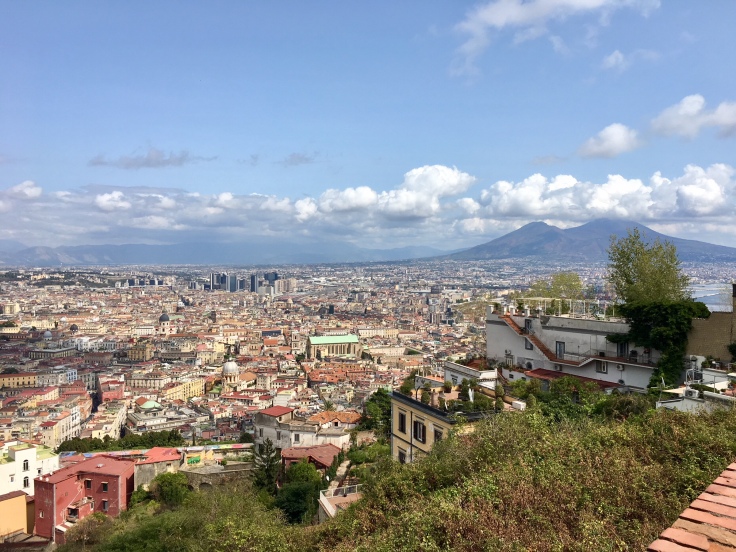
The Museo di San Martino, a former monastery, gives a great view on both sides of the city while sheltering an incredible chapel.

One Place To Eat: Pizzeria San Michele – Next to via Duomo, the place where the original margherita pizza (named after the Queen Margherita of Savoy) was fathered! The restaurant does this only pizza, and people queuing for hours hoping to have a piece of it. Come early and grab your ticket!
Walking down on via Toledo from Piazza Dante is a journey, as shops differ as long as you move into the street.
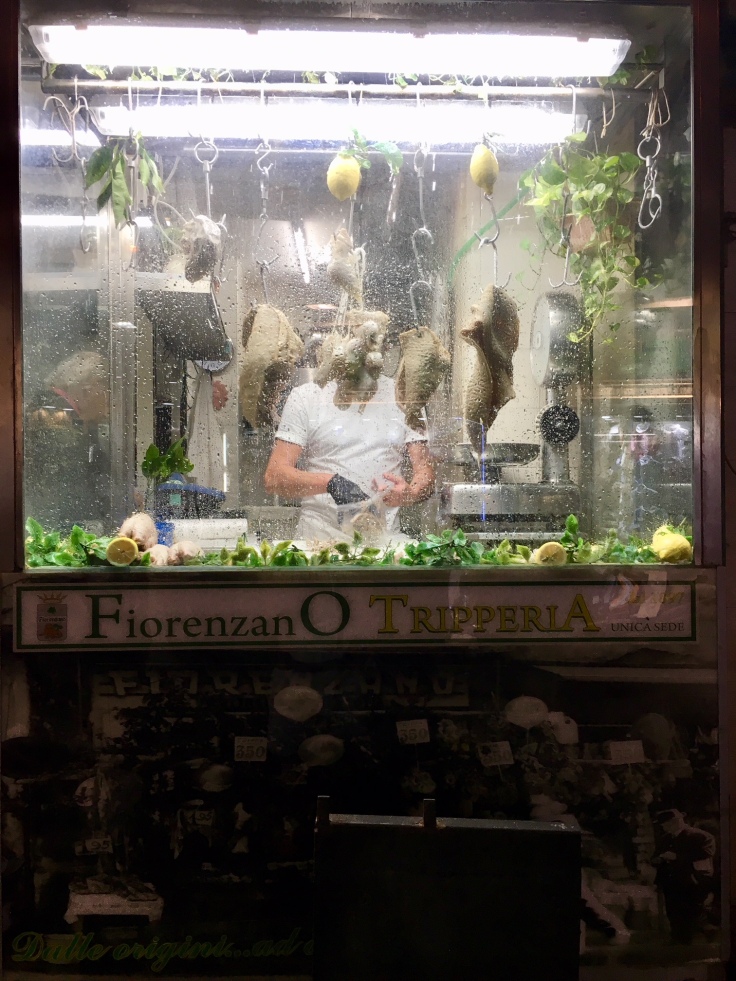
Via Toledo leads to one of the wonders of Naples, the galleria Umberto I, through the Naples City Hall and the Castel Nuovo, built by the French Charles d’Anjou in the XIII century. The galleria was designed by Emmanuele Rocco in the same style than the galleria Vittorio Emanuele II in Milan in the XIX century.

One Place to Drink: Gran Café Gambrinius, at the end of via Toledo – Built in 1860, this café belongs to the history of Naples. Sit inside and enjoy the frescoes on the walls, while tasting the specialty of the house, the hazelnut coffee
Gran Café Gambrinius was also the place, where, among others, Guy de Maupassant, Oscar Wilde, Giovanni Bovio were used to be seen. It was close in 1938, as a key location for opponents to the Mussolini fascist regime, and reopened in the early seventies.
Piazza del Plebiscito is called as such thanks to the plebiscite of October 2, which brought Naples into the united kingdom of Italy, after belonging for a long time to the Bourbons.
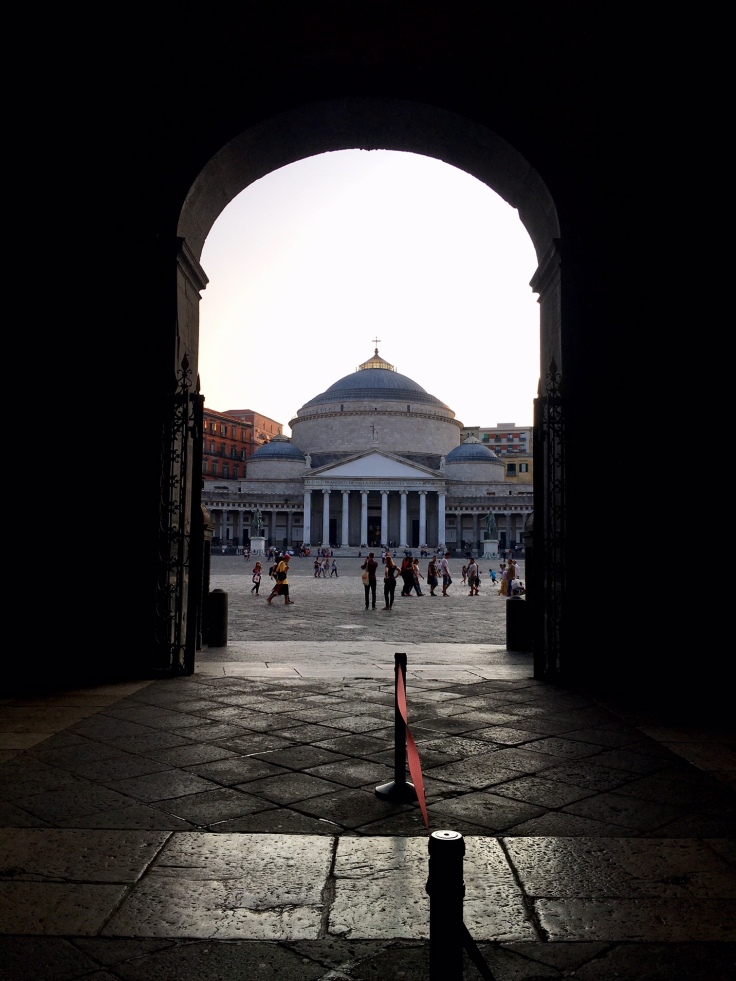
The square is circled with the Basilique San Francesco di Paola, the Biblioteca Nazionale de Napoli Vittorio, and the Palazzo Salerno.

From Piazza del Plebiscito, take Via Chaia, one the most known shopping streets of Naples, which will lead you to the Ponte di Chaia, via dei Mille –the street with all the luxury shops, and the lively area full of bars and restaurants of Chaia, via Giuseppe Fiorelli and Vico Bellodone a Chaia.
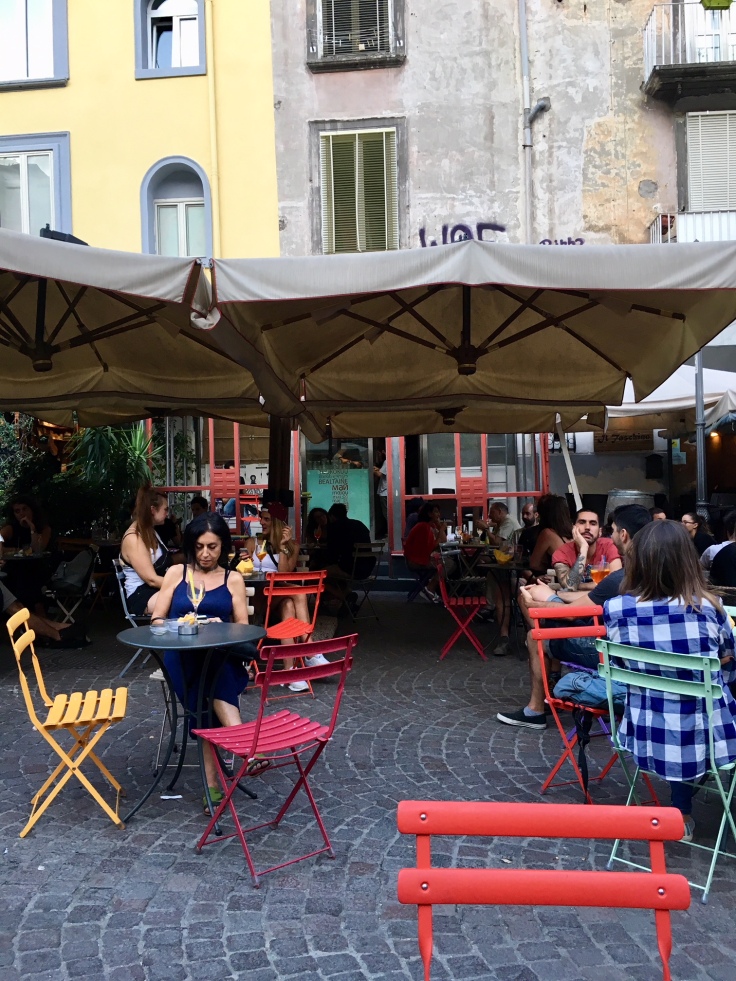
Not far is the third castle of Naples, Castel Dell’Ovo, built by the Norman Kings. The castle has a great view on both bays on Naples: On one side, the harbor and Naples. One the other side, where sunset is, Chaia.
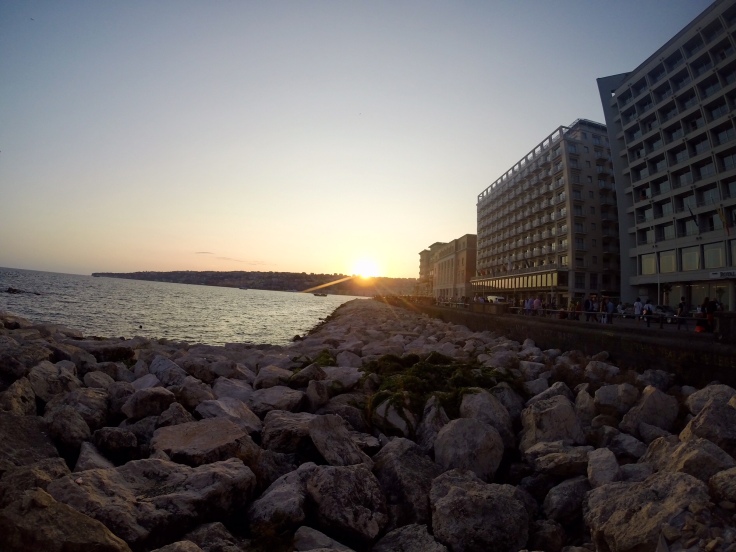
One Place To Stay: B&B Duomo Station, in Via Duomo – Ana is really kind and helpful for everything. Her place is ideally located and charming !

Leave a comment